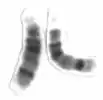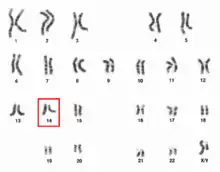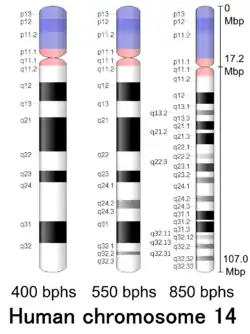Chromosome 14
| Chromosome 14 | |
|---|---|
 Human chromosome 14 pair after G-banding. One is from mother, one is from father. | |
 Chromosome 14 pair in human male karyogram. | |
| Features | |
| Length (bp) | 107,043,718 bp (GRCh38)[1] |
| No. of genes | 583 (CCDS)[2] |
| Type | Autosome |
| Centromere position | Acrocentric[3] (17.2 Mbp[4]) |
| Complete gene lists | |
| CCDS | Gene list |
| HGNC | Gene list |
| UniProt | Gene list |
| NCBI | Gene list |
| External map viewers | |
| Ensembl | Chromosome 14 |
| Entrez | Chromosome 14 |
| NCBI | Chromosome 14 |
| UCSC | Chromosome 14 |
| Full DNA sequences | |
| RefSeq | NC_000014 (FASTA) |
| GenBank | CM000676 (FASTA) |
Chromosome 14 is one of the 23 pairs of chromosomes in humans. People normally have two copies of this chromosome. Chromosome 14 spans about 107 million base pairs (the building material of DNA) and represents between 3 and 3.5% of the total DNA in cells.
The centromere of chromosome 14 is positioned approximately at position 17.2 Mbp.
Genes
Number of genes
The following are some of the gene count estimates of human chromosome 14. Because researchers use different approaches to genome annotation their predictions of the number of genes on each chromosome varies (for technical details, see gene prediction). Among various projects, the collaborative consensus coding sequence project (CCDS) takes an extremely conservative strategy. So CCDS's gene number prediction represents a lower bound on the total number of human protein-coding genes.[5]
| Estimated by | Protein-coding genes | Non-coding RNA genes | Pseudogenes | Source | Release date |
|---|---|---|---|---|---|
| CCDS | 583 | — | — | [2] | 2016-09-08 |
| HGNC | 593 | 324 | 513 | [6] | 2017-05-12 |
| Ensembl | 820 | 856 | 518 | [7] | 2017-03-29 |
| UniProt | 720 | — | — | [8] | 2018-02-28 |
| NCBI | 621 | 690 | 598 | [9][10][11] | 2017-05-19 |
Gene list
The following is a partial list of genes on human chromosome 14. For complete list, see the link in the infobox on the right.
- ACIN1: encoding protein Apoptotic chromatin condensation inducer in the nucleus
- ATXN3: Ataxin-3 (Machado-Joseph disease)
- BCL2L2: encoding the anti-apoptotic protein Bcl-w of the Bcl-2 family
- C14orf93: encoding protein C14orf93
- CLBA1: encoding protein CLBA1
- CDC42BPB: encoding protein CDC42 binding protein kinase beta
- CHMP4A: Charged multivesicular body protein 4a
- CIDEB: Cell death-inducing DFFA-like effector b
- CMA1: encoding enzyme Chymase
- CNIH: encoding protein Protein cornichon homolog
- COCH: coagulation factor C homolog, cochlin (Limulus polyphemus)
- CRIP2: Cysteine-rich protein 2
- DDX24: encoding enzyme ATP-dependent RNA helicase DDX24
- DEGS2: encoding protein Delta(4)-desaturase, sphingolipid 2
- DLGAP5: Disks large-associated protein 5
- DGLUCY: encoding protein DGLUCY, mitochondrial
- EAPP: E2F-associated phosphoprotein
- EGLN3: Egl nine homolog 3
- ENTPD5: Ectonucleoside triphosphate diphosphohydrolase 5
- ERG28: encoding protein Probable ergosterol biosynthetic protein 28
- Fam158a: encoding protein UPF0172 protein FAM158A
- FAM181A: encoding protein Family with sequence similarity 181, member A
- FAM71D: Family With Sequence Similarity 71, Member D
- FCF1: rRNA-processing protein FCF1 homolog
- GALC: galactosylceramidase (Krabbe disease)
- GARNL1: GTPase-activating Rap/Ran-GAP domain-like 1
- GCH1: GTP cyclohydrolase 1 (dopa-responsive dystonia)
- GPHB5: Glycoprotein hormone beta-5
- GSKIP encoding protein GSK3B interacting protein
- HHIPL1: encoding protein HHIP-like protein 1
- IFI27: encoding protein Interferon alpha-inducible protein 27
- IFT43: intraflagellar transport 43
- IGH@: immunoglobulin heavy chain locus
- IRF2BPL: encoding protein Interferon regulatory factor 2 binding protein like
- ITPK1: encoding enzyme Inositol-tetrakisphosphate 1-kinase
- JKAMP: encoding protein JNK1-associated membrane protein
- JPH4: encoding protein Junctophilin 4
- LINC00520: a long non-coding RNA
- MAPK1IP1L: encoding protein MAPK-interacting and spindle-stabilizing protein-like
- MIA2: encoding protein Melanoma inhibitory activity protein 2
- MIR494 encoding protein MicroRNA 494
- MIR3173: encoding protein MicroRNA 3173
- MIS18BP1: encoding protein MIS18 binding protein 1
- MOAP1: encoding protein Modulator of apoptosis 1
- MYH7: myosin heavy chain beta (MHC-β) isoform[12]
- NPC2: Niemann-Pick disease, type C2
- NUBPL: encoding protein Iron-sulfur protein NUBPL (IND1)
- OSGEP: encoding enzyme Probable O-sialoglycoprotein endopeptidase
- PAPOLA: encoding enzyme Poly(A) polymerase alpha
- PCNX: encoding protein Pecanex-like protein 1
- PELI2: encoding protein Protein pellino homolog 2
- PSEN1: presenilin 1 (Alzheimer disease 3)
- RIOX1: encoding protein RIOX1
- RTRAF: encoding protein protein RTRAF
- RPL10L: encoding protein 60S ribosomal protein L10-like
- SERPINA1: serpin peptidase inhibitor, clade A (alpha-1 antiproteinase, antitrypsin), member 1
- SIX6OS1: encoding protein SIX6OS1
- SGPP1: encoding enzyme Sphingosine-1-phosphate phosphatase 1
- TC2N: encoding protein Tandem C2 domains nuclear protein
- TCL1B: encoding protein T-cell leukemia/lymphoma protein 1B
- TIMM9: encoding enzyme Mitochondrial import inner membrane translocase subunit Tim9
- TMED10: encoding protein Transmembrane emp24 domain-containing protein 10
- TMEM260: encoding protein TMEM260
- TRAJ56: encoding protein T cell receptor alpha joining 56
- TRAV12-2: encoding protein T cell receptor alpha variable 12-2
- TSHR: thyroid stimulating hormone receptor
- TUNAR: a long non-coding RNA
- VASH1: encoding protein Vasohibin-1
- VIPAS39: encoding protein VIPAS39
- WARS: encoding enzyme Tryptophanyl-tRNA synthetase, cytoplasmic
- YLPM1: encoding protein YLP motif-containing protein 1
- ZBTB1: encoding protein Zinc finger and BTB domain containing 1
- ZFHX2: encoding protein Zinc finger homeobox 2
- ZNF839: encoding protein Zinc finger protein 839
Diseases and disorders
The following diseases are some of those related to genes on chromosome 14:
- Alzheimer disease
- Burkitt's lymphoma (t8;14)
- congenital hypothyroidism
- dopamine-responsive dystonia
- Follicular lymphoma (t14;18)
- FOXG1 Syndrome
- Hypertrophic cardiomyopathy
- Krabbe disease
- Cranio-lenticulo-sutural dysplasia
- Machado-Joseph disease
- Mosaic monosomy 14
- Multiple myeloma
- Niemann-Pick disease
- Nonsyndromic deafness
- Sensenbrenner syndrome
- Tetrahydrobiopterin deficiency
- Uniparental disomy (UPD) 14
Cytogenetic band
| Chr. | Arm[18] | Band[19] | ISCN start[20] |
ISCN stop[20] |
Basepair start |
Basepair stop |
Stain[21] | Density |
|---|---|---|---|---|---|---|---|---|
| 14 | p | 13 | 0 | 284 | 1 | 3,600,000 | gvar | |
| 14 | p | 12 | 284 | 624 | 3,600,001 | 8,000,000 | stalk | |
| 14 | p | 11.2 | 624 | 1249 | 8,000,001 | 16,100,000 | gvar | |
| 14 | p | 11.1 | 1249 | 1433 | 16,100,001 | 17,200,000 | acen | |
| 14 | q | 11.1 | 1433 | 1660 | 17,200,001 | 18,200,000 | acen | |
| 14 | q | 11.2 | 1660 | 2043 | 18,200,001 | 24,100,000 | gneg | |
| 14 | q | 12 | 2043 | 2313 | 24,100,001 | 32,900,000 | gpos | 100 |
| 14 | q | 13.1 | 2313 | 2469 | 32,900,001 | 34,800,000 | gneg | |
| 14 | q | 13.2 | 2469 | 2582 | 34,800,001 | 36,100,000 | gpos | 50 |
| 14 | q | 13.3 | 2582 | 2724 | 36,100,001 | 37,400,000 | gneg | |
| 14 | q | 21.1 | 2724 | 2923 | 37,400,001 | 43,000,000 | gpos | 100 |
| 14 | q | 21.2 | 2923 | 3008 | 43,000,001 | 46,700,000 | gneg | |
| 14 | q | 21.3 | 3008 | 3264 | 46,700,001 | 50,400,000 | gpos | 100 |
| 14 | q | 22.1 | 3264 | 3491 | 50,400,001 | 53,600,000 | gneg | |
| 14 | q | 22.2 | 3491 | 3604 | 53,600,001 | 55,000,000 | gpos | 25 |
| 14 | q | 22.3 | 3604 | 3718 | 55,000,001 | 57,600,000 | gneg | |
| 14 | q | 23.1 | 3718 | 3916 | 57,600,001 | 61,600,000 | gpos | 75 |
| 14 | q | 23.2 | 3916 | 4044 | 61,600,001 | 64,300,000 | gneg | |
| 14 | q | 23.3 | 4044 | 4186 | 64,300,001 | 67,400,000 | gpos | 50 |
| 14 | q | 24.1 | 4186 | 4484 | 67,400,001 | 69,800,000 | gneg | |
| 14 | q | 24.2 | 4484 | 4626 | 69,800,001 | 73,300,000 | gpos | 50 |
| 14 | q | 24.3 | 4626 | 4839 | 73,300,001 | 78,800,000 | gneg | |
| 14 | q | 31.1 | 4839 | 5051 | 78,800,001 | 83,100,000 | gpos | 100 |
| 14 | q | 31.2 | 5051 | 5094 | 83,100,001 | 84,400,000 | gneg | |
| 14 | q | 31.3 | 5094 | 5349 | 84,400,001 | 89,300,000 | gpos | 100 |
| 14 | q | 32.11 | 5349 | 5406 | 89,300,001 | 91,400,000 | gneg | |
| 14 | q | 32.12 | 5406 | 5505 | 91,400,001 | 94,200,000 | gpos | 25 |
| 14 | q | 32.13 | 5505 | 5619 | 94,200,001 | 95,800,000 | gneg | |
| 14 | q | 32.2 | 5619 | 5732 | 95,800,001 | 100,900,000 | gpos | 50 |
| 14 | q | 32.31 | 5732 | 5903 | 100,900,001 | 102,700,000 | gneg | |
| 14 | q | 32.32 | 5903 | 6016 | 102,700,001 | 103,500,000 | gpos | 50 |
| 14 | q | 32.33 | 6016 | 6300 | 103,500,001 | 107,043,718 | gneg |
References
- ↑ "Human Genome Assembly GRCh38 - Genome Reference Consortium". National Center for Biotechnology Information. 2013-12-24. Retrieved 2017-03-04.
- 1 2 "Search results - 14[CHR] AND "Homo sapiens"[Organism] AND ("has ccds"[Properties] AND alive[prop]) - Gene". NCBI. CCDS Release 20 for Homo sapiens. 2016-09-08. Retrieved 2017-05-28.
- ↑ Tom Strachan; Andrew Read (2 April 2010). Human Molecular Genetics. Garland Science. p. 45. ISBN 978-1-136-84407-2.
- 1 2 Genome Decoration Page, NCBI. Ideogram data for Homo sapience (850 bphs, Assembly GRCh38.p3). Last update 2014-06-03. Retrieved 2017-04-26.
- ↑ Pertea M, Salzberg SL (2010). "Between a chicken and a grape: estimating the number of human genes". Genome Biol. 11 (5): 206. doi:10.1186/gb-2010-11-5-206. PMC 2898077. PMID 20441615.
- ↑ "Statistics & Downloads for chromosome 14". HUGO Gene Nomenclature Committee. 2017-05-12. Retrieved 2017-05-19.
- ↑ "Chromosome 14: Chromosome summary - Homo sapiens". Ensembl Release 88. 2017-03-29. Retrieved 2017-05-19.
- ↑ "Human chromosome 14: entries, gene names and cross-references to MIM". UniProt. 2018-02-28. Retrieved 2018-03-16.
- ↑ "Search results - 14[CHR] AND "Homo sapiens"[Organism] AND ("genetype protein coding"[Properties] AND alive[prop]) - Gene". NCBI. 2017-05-19. Retrieved 2017-05-20.
- ↑ "Search results - 14[CHR] AND "Homo sapiens"[Organism] AND ( ("genetype miscrna"[Properties] OR "genetype ncrna"[Properties] OR "genetype rrna"[Properties] OR "genetype trna"[Properties] OR "genetype scrna"[Properties] OR "genetype snrna"[Properties] OR "genetype snorna"[Properties]) NOT "genetype protein coding"[Properties] AND alive[prop]) - Gene". NCBI. 2017-05-19. Retrieved 2017-05-20.
- ↑ "Search results - 14[CHR] AND "Homo sapiens"[Organism] AND ("genetype pseudo"[Properties] AND alive[prop]) - Gene". NCBI. 2017-05-19. Retrieved 2017-05-20.
- ↑ Quiat D, Voelker KA, Pei J, Grishin NV, Grange RW, Bassel-Duby R, Olson EN (June 2011). "Concerted regulation of myofiber-specific gene expression and muscle performance by the transcriptional repressor Sox6". Proc. Natl. Acad. Sci. U.S.A. 108 (25): 10196–201. Bibcode:2011PNAS..10810196Q. doi:10.1073/pnas.1107413108. PMC 3121857. PMID 21633012.
- ↑ Genome Decoration Page, NCBI. Ideogram data for Homo sapience (400 bphs, Assembly GRCh38.p3). Last update 2014-03-04. Retrieved 2017-04-26.
- ↑ Genome Decoration Page, NCBI. Ideogram data for Homo sapience (550 bphs, Assembly GRCh38.p3). Last update 2015-08-11. Retrieved 2017-04-26.
- ↑ International Standing Committee on Human Cytogenetic Nomenclature (2013). ISCN 2013: An International System for Human Cytogenetic Nomenclature (2013). Karger Medical and Scientific Publishers. ISBN 978-3-318-02253-7.
- ↑ Sethakulvichai, W.; Manitpornsut, S.; Wiboonrat, M.; Lilakiatsakun, W.; Assawamakin, A.; Tongsima, S. (2012). "Estimation of band level resolutions of human chromosome images". In Computer Science and Software Engineering (JCSSE), 2012 International Joint Conference on: 276–282. doi:10.1109/JCSSE.2012.6261965. ISBN 978-1-4673-1921-8. S2CID 16666470.
- ↑ Genome Decoration Page, NCBI. Ideogram data for Homo sapience (850 bphs, Assembly GRCh38.p3). Last update 2014-06-03. Retrieved 2017-04-26.
- ↑ "p": Short arm; "q": Long arm.
- ↑ For cytogenetic banding nomenclature, see article locus.
- 1 2 These values (ISCN start/stop) are based on the length of bands/ideograms from the ISCN book, An International System for Human Cytogenetic Nomenclature (2013). Arbitrary unit.
- ↑ gpos: Region which is positively stained by G banding, generally AT-rich and gene poor; gneg: Region which is negatively stained by G banding, generally CG-rich and gene rich; acen Centromere. var: Variable region; stalk: Stalk.
- Campo E (2003). "Genetic and molecular genetic studies in the diagnosis of B-cell lymphomas I: mantle cell lymphoma, follicular lymphoma, and Burkitt's lymphoma". Hum Pathol. 34 (4): 330–5. doi:10.1053/hupa.2003.97. PMID 12733111.
- Gilbert F (1999). "Disease genes and chromosomes: disease maps of the human genome. Chromosome 14". Genet Test. 3 (4): 379–91. doi:10.1089/gte.1999.3.379. PMID 10627948.
- Heilig R, Eckenberg R, Petit JL, Fonknechten N, Da Silva C, Cattolico L, Levy M, Barbe V, de Berardinis V, Ureta-Vidal A, Pelletier E, Vico V, Anthouard V, Rowen L, Madan A, Qin S, Sun H, Du H, Pepin K, Artiguenave F, Robert C, Cruaud C, Bruls T, Jaillon O, Friedlander L, Samson G, Brottier P, Cure S, Segurens B, Aniere F, Samain S, Crespeau H, Abbasi N, Aiach N, Boscus D, Dickhoff R, Dors M, Dubois I, Friedman C, Gouyvenoux M, James R, Madan A, Mairey-Estrada B, Mangenot S, Martins N, Menard M, Oztas S, Ratcliffe A, Shaffer T, Trask B, Vacherie B, Bellemere C, Belser C, Besnard-Gonnet M, Bartol-Mavel D, Boutard M, Briez-Silla S, Combette S, Dufosse-Laurent V, Ferron C, Lechaplais C, Louesse C, Muselet D, Magdelenat G, Pateau E, Petit E, Sirvain-Trukniewicz P, Trybou A, Vega-Czarny N, Bataille E, Bluet E, Bordelais I, Dubois M, Dumont C, Guerin T, Haffray S, Hammadi R, Muanga J, Pellouin V, Robert D, Wunderle E, Gauguet G, Roy A, Sainte-Marthe L, Verdier J, Verdier-Discala C, Hillier L, Fulton L, McPherson J, Matsuda F, Wilson R, Scarpelli C, Gyapay G, Wincker P, Saurin W, Quetier F, Waterston R, Hood L, Weissenbach J (2003). "The DNA sequence and analysis of human chromosome 14". Nature. 421 (6923): 601–7. Bibcode:2003Natur.421..601H. doi:10.1038/nature01348. PMID 12508121.
- Kamnasaran D, Cox DW (2002). "Current status of human chromosome 14". J Med Genet. 39 (2): 81–90. doi:10.1136/jmg.39.2.81. PMC 1735028. PMID 11836355.
- Lemire EG, Cardwell S (1999). "Unusual phenotype in partial trisomy 14". Am J Med Genet. 87 (4): 294–6. doi:10.1002/(SICI)1096-8628(19991203)87:4<294::AID-AJMG2>3.0.CO;2-S. PMID 10588832.
- van Karnebeek CD, Quik S, Sluijter S, Hulsbeek MM, Hoovers JM, Hennekam RC (2002). "Further delineation of the chromosome 14q terminal deletion syndrome". Am J Med Genet. 110 (1): 65–72. doi:10.1002/ajmg.10207. PMID 12116274.
External links
| Wikimedia Commons has media related to Human chromosome 14. |
- National Institutes of Health. "Chromosome 14". Genetics Home Reference. Archived from the original on 2012-02-04. Retrieved 2017-05-06.
- "Chromosome 14". Human Genome Project Information Archive 1990–2003. Retrieved 2017-05-06.

